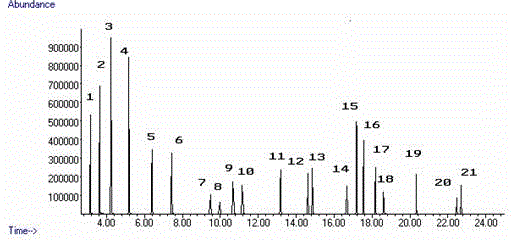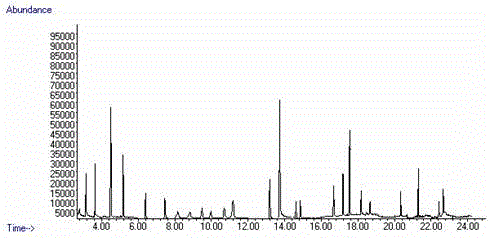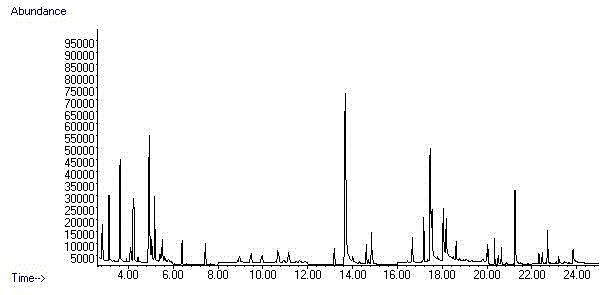Detection method for residual quantity of multiple preservatives in cosmetics
A detection method and cosmetic technology, applied in the fields of analytical chemistry and food safety, can solve the problem that the preservative determination method cannot meet the requirements of national health supervision, and achieve the effect of satisfying the precision and the recovery rate.
- Summary
- Abstract
- Description
- Claims
- Application Information
AI Technical Summary
Problems solved by technology
Method used
Image
Examples
Embodiment 1
[0046] Example 1 Detection method of multiple preservative residues in cream cosmetics
[0047] 1. Sample extraction and purification:
[0048] Weigh 0.2 g sample (accurate to 0.001 g) into a 50 mL Erlenmeyer flask, add 10 mL tetrahydrofuran, sonicate for 10 min, filter through a 0.45 μm membrane, and inject the sample.
[0049] 2. Determination by gas chromatography-mass spectrometer
[0050] ①Qualitative determination: Measure the sample solution and standard solution respectively according to gas chromatography / mass spectrometry conditions. If the GC-MS data of the sample meets the following restrictions, it can be qualitatively determined as a certain preservative residue:
[0051]A. The substance to be tested in the sample has the same retention time as the standard substance, and the deviation is within ±2.5%;
[0052] B. The signal-to-noise ratio of the monitored ions should be ≥3;
[0053] C. There are all selected monitoring ions in the mass spectrum of the peak af...
Embodiment 2
[0090] Example 2 Detection method of multiple preservative residues in milky cosmetics
[0091] 1. Sample extraction and purification: same as Example 1.
[0092] 2. Measurement by gas chromatography-mass spectrometer: the same as in Example 1.
[0093] 3. Linear relationship: with embodiment 1.
[0094] 4. The lower limit of detection: the same as in Example 1.
[0095] 5. Recovery rate and precision: Accurately weigh the milky sample without preservatives, add 3 different content levels of 21 kinds of preservative mixed standard solutions, and carry out 6 parallel samples for each concentration, and carry out according to the above chromatographic conditions analyze. The calculation results of recovery rate and coefficient of variation are shown in Table 5.
[0096] Table 5 Recovery rate (%) and relative standard deviation (%) of 21 kinds of preservatives in cosmetics in milk samples
[0097]
[0098] From the results in Table 5, it can be seen that the average recov...
Embodiment 3
[0099] Example 3 Detection method of multiple preservative residues in water-like cosmetics
[0100] 1. Sample extraction and purification: same as Example 1.
[0101] 2. Measurement by gas chromatography-mass spectrometer: the same as in Example 1.
[0102] 3. Linear relationship: with embodiment 1.
[0103] 4. The lower limit of detection: the same as in Example 1.
[0104] 5. Recovery rate and precision: Accurately weigh the water sample without preservatives, add 21 kinds of preservatives mixed standard solutions with 3 different content levels, and carry out 6 parallel samples for each concentration, according to the above chromatographic conditions for analysis. The calculation results of recovery rate and coefficient of variation are shown in Table 6.
[0105] Table 6 Recovery rate (%) and relative standard deviation (%) of 21 kinds of preservatives in cosmetics in aqueous samples
[0106]
[0107] From the results in Table 6, it can be seen that the average rec...
PUM
| Property | Measurement | Unit |
|---|---|---|
| Ionization energy | aaaaa | aaaaa |
| Ion source temperature | aaaaa | aaaaa |
Abstract
Description
Claims
Application Information
 Login to View More
Login to View More - R&D
- Intellectual Property
- Life Sciences
- Materials
- Tech Scout
- Unparalleled Data Quality
- Higher Quality Content
- 60% Fewer Hallucinations
Browse by: Latest US Patents, China's latest patents, Technical Efficacy Thesaurus, Application Domain, Technology Topic, Popular Technical Reports.
© 2025 PatSnap. All rights reserved.Legal|Privacy policy|Modern Slavery Act Transparency Statement|Sitemap|About US| Contact US: help@patsnap.com



